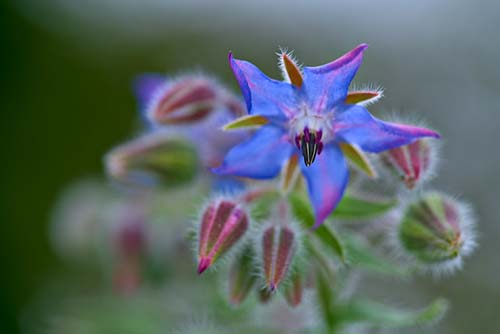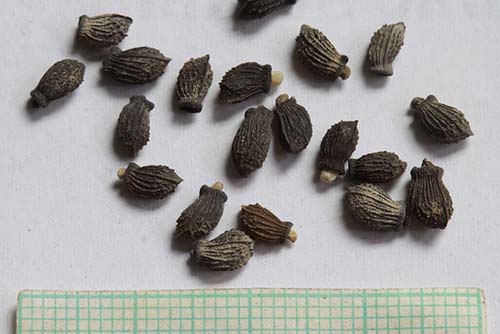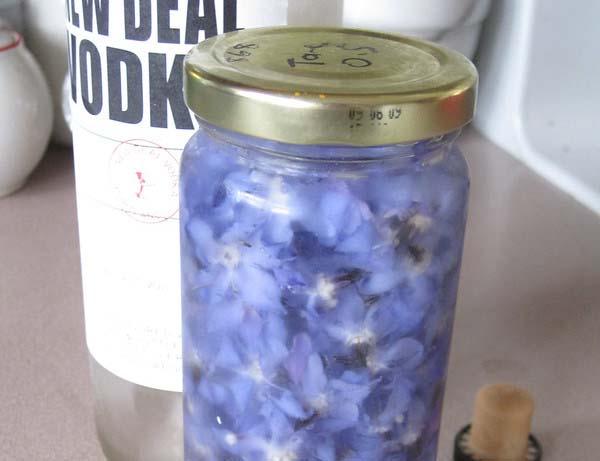Borage is quickly becoming one of my favorite plants. Not only is it beautiful, easy to grow, and tastes good, but it also has a slew of health benefits – especially for the skin. These skin benefits are why borage seed oil is becoming popular and found in many beauty products.
There’s still a lot of confusion around borage oil and how it should be used though. Here’s what you need to know, including what it treats, dosage information and whether you can put it directly on your skin.
What Is Borage?

Borage is a plant with beautiful star-shaped blue flowers. It probably originated in the Mediterranean region or Syria. Borage has been used medicinally for centuries but only recently became popular as a treatment for skin conditions because of its high amounts of gamma-linolenic acid (GLA).
Both the leaves and flowers of borage are edible. The leaves taste like cucumber and the flowers taste like honey. It is sometimes used in Mediterranean and Middle Eastern food. While traveling in Italy, for example, I found borage-filled ravioli, borage flower yogurt, and dried borage herb in specialty supermarkets.
Other Names for Borage
- Borago officinalis (Latin)
- Star flower
- Tailwort
- Common bugloss
- Borragine (Italian)
- Borraja (Spanish)
- Lisan al thawr (Arabic)
Borage Seeds vs. Leaves and Flowers

For skin and hair, borage seeds are usually used. The seeds are pressed to extract their oil which can then be applied to the skin or taken as a supplement. However, borage leaves and flowers can also be used medicinally
Various studies have found that borage leaves and flowers contain dozens of healthy compounds including antioxidants – including phenolic acids, flavonoids, and oleuropein. These compounds have benefits that range from improved respiration to fighting cancer. The leaves also contain fatty acids including ALA and GLA. (1, 2)
Many people grow borage plant so they can eat the tasty plant and get these health benefits. It’s also possible to find tincture from borage leaves sold online. Unlike with borage seed oil, tinctures should only be used internally and not applied to the skin.

Benefits of Borage Seed Oil
1. Source of Gamma-Linolenic Acid
Borage seed oil is best known as a source of gamma-linolenic acid (GLA). It contains more GLA than any other plant oil. Approximately 20%-38% of borage seed oil is GLA, which is more than is found in any other known plant. Evening primrose oil, for example, only contains 7%-12% GLA and black current oil contains 15%-20% GLA.
GLA is incredibly important for reducing inflammation. It works by regulating inflammation pathways (it modulates eicosanoids, cytokines, and genes that regulate apoptosis). The body also converts it into hormone-like prostaglandins, which work directly at the site of tissue damage to reduce inflammation.
Because inflammation is the root cause of so many diseases, borage seed oil has shown benefits in treating skin disorders, arthritis, some cancers, and diabetes.
2. Rich in Fatty Acids
In addition to GLA, borage seed oil also contains other healthy fatty acids including:
- Stearidonic acid
- Linoleic acid
- Oleic acid
- Palmitic acid
- Stearic acid
- Eiconsenoic acid
- Erucic acid
These fatty acids have a wide range of benefits, such as fighting inflammation, reducing cholesterol, improving immunity and supporting bone health. Some of these fatty acids, such as Eiconsenoic acid, are particularly good for the skin.
3. Antioxidants
Borage seed oil is very rich in phenolic antioxidants. In particularly, it contains high amounts of rosmarinic acid. This antioxidant has numerous benefits, including:
- Antimicrobial
- Boosts mood and memory
- Promotes hair growth
- Protects eye health and vision
- Treating diabetes
4. Acne
The strong antioxidants in borage seed oil are also good for treating acne. Applied topically, it can help kill the bacteria which cause whitehead pimples. The anti-inflammatory properties of borage oil also help reduce acne redness.
5. Psoriasis and Eczema
Borage seed oil treats psoriasis and eczema on multiple fronts. When taken as a supplement, it helps reduce inflammation. Because the root cause of psoriasis and eczema is inflammation, borage seed oil can help treat these skin disorders from the inside-out.
When applied topically, the GLA content of the oil helps hydrate the skin, which is important because the skin is not able to produce its own GLA. This makes borage oil great for moisturizing the skin and reducing itchiness. It also helps strengthen the skin barrier, which can help heal damaged skin.
Various studies, both on animal and human subjects, have shown that borage oil does indeed help these skin disorders. However, it is worth noting that borage oil alone probably won’t cure severe cases of eczema or psoriasis. You’ll need to make substantial changes to your diet and lifestyle, and possible take an anti-inflammatory like turmeric or atractylodes to truly cure the root cause of these disorders.
6. Arthritis
Borage seed oil is sometimes used as a natural treatment for arthritis. It can be applied topically or taken as a supplement to help reduce the inflammation which causes arthritis pain.
Sources: 3, 4, 5, 6, 7, 8, 9, 10,11,12,13, 14
How to Use Borage Oil
Can borage seed oil be applied directly to the skin?
Yes, borage seed oil can be applied directly to skin. This is generally recommended for treated inflamed skin. However, when used for general moisturizing or cleansing, borage oil is usually mixed with other oils such as olive oil or almond oil.
On Hair
- Put the borage seed oil in an applicator bottle (pointy tip) or a bottle with an eye-dropper.
- Add other oils (optional) such as castor, argon, almond or jojoba. Aim to have at least 10% of the mixture contain borage seed oil.
- Before going to bed, apply the oil to your scalp. It helps to work in sections.
- Massage the oil into your scalp.
- Pin your hair on top of your head and put on a cap.
- Keep the oil on overnight. In the morning, shampoo and condition your
- Repeat 1-2 times per week.
For Cleansing the Face
- Start with a dry face.
- Put about ½ tsp. to 1 tsp. of borage oil into your palm.
- Dab your ring finger into the oil and apply it to your face.
- Massage the oil into your skin, especially focusing on any problem areas.
- Put a washcloth under hot (but not too hot!) water and then wring it out.
- Apply the washcloth to your face. The heat will open your pores and draw out impurities.
- Keep the washcloth in place until it cools down.
- Use the washcloth to gently wipe the oil off your face.
- If your face still feels oily, you can use a mixture of vinegar and water to rinse your face. Mix ¼ cup of water with 1 Tbsp. of ACV. Wet a cotton ball with it and gently rub your face.
For Acne
- First cleanse your face. You can use the oil method from above.
- Using a cotton swab, apply a small amount of borage seed oil to pimples.
- Allow the oil to soak in.
- Repeat morning and night.
Borage Seed Oil Supplements
When taken as an oral supplement, borage seed oil can reduce inflammation and help treat arthritis, psoriasis and eczema. There are many brands which sell borage oil in capsules. The best brands will list the amount of GLA their product contains.
Dosage
The recommended dosage of borage seed oil is usually 1000mg per day. This will provide approximately 180mg to 240mg of GLA. Some brands say to take up to 2000mg of their borage oil per day.
Note that some health organizations recommend higher amounts of GLA per day. For example:
- Skin conditions: 360-750mg of GLA per day
- Diabetes-related nerve pain: 360-480mg of GLA per day
- Rheumatoid arthritis: 750mg-2.8g of GLA per day
You’ll have to check with your doctor to determine the right borage seed oil for your needs. (15,16, 17)
Borage Oil Side Effects
Borage seed oil is not known to cause any severe side effects. Oral supplements might cause gas, bloating, or upset stomach.
As when trying any new skin oil, apply a small amount of borage oil on your skin at first. Wait to see if you have a reaction before applying any more to your skin. (18)
Important: How to Store Borage Oil
The nutrients in borage seed oil are very sensitive to heat and light. It is very important that you keep it in a cool, dark place. Ideally, keep borage seed oil in your refrigerator. Don’t keep it in the bathroom because the heat from the shower can cause the oil to degrade faster.
Best Borage Seed Oil
When looking for borage seed oil, choose brands which specifically list how much GLA their product contains. Also look for borage oil which comes in dark packaging; this protects the oil from damage from UV light. Below are some of the best brands of borage seed oil – both topical and capsules.
1. Naissance Borage Oil
- 100% pure borage oil
- Certified organic
- Comes in 3.4oz and 8oz sizes
- Cold-pressed
- Topical or oral use
- Buy Here
2. US Organic Borage Oil
- 100% pure borage oil
- Certified organic
- 2oz bottle with eyedropper
- Cold-pressed
- Topical use
- 18% GLA
- Buy Here
3. NOW Borage Oil Capsules
- 60 gel capsules
- 1000mg borage oil per capsule
- 24% GLA (240mg per capsule)
- Packed in the USA
- Buy Here
4. Barleans Borage Oil
- 60 gel capsules
- 1000mg borage oil per capsule
- 20% GLA (200mg per capsule)
- Buy Here
5. DEVA Vegan Borage Oil Capsules
- 90 vegan capsules
- 500mg borage oil per capsule
- Minimum 18% GLA (90mg per capsule)
- Buy Here
Image credits:
“Borage” (CC BY-ND 2.0) by pstenzel71
“Borage” (CC BY-ND 2.0) by pstenzel71
“Borage” (CC BY 2.0) by Dominic’s pics
“envodka’d” (CC BY-NC-SA 2.0) by ideath,
“2014.04.05_12.08.29_IMG_7292-Borago_offi” (CC BY 2.0) by AndreyZharkikh,
“starr-160202-0428-Borago_officinalis-lea” (CC BY 2.0) by Starr Environmental






